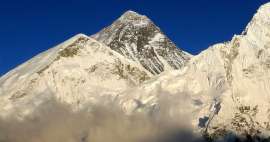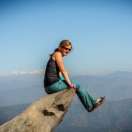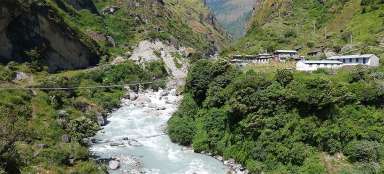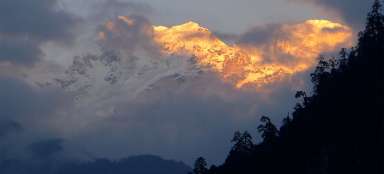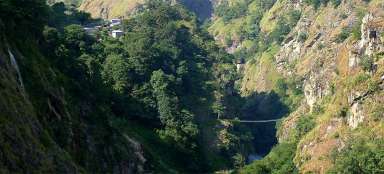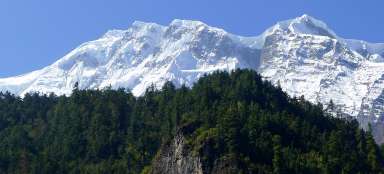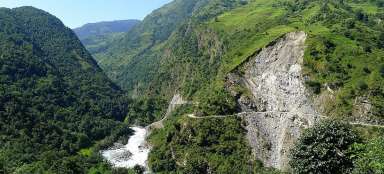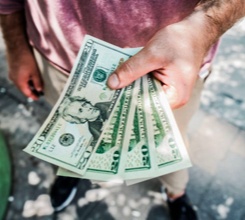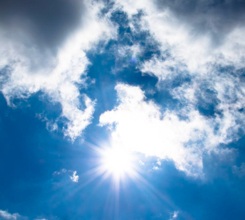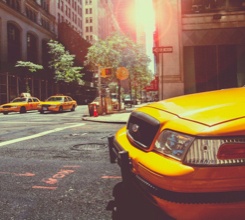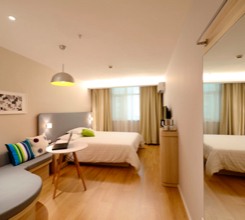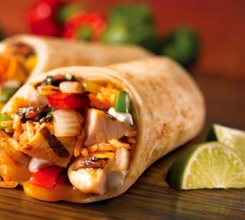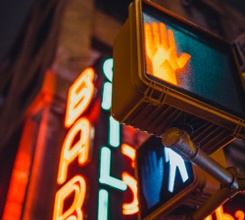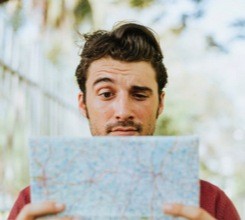19-day trek around Manasl
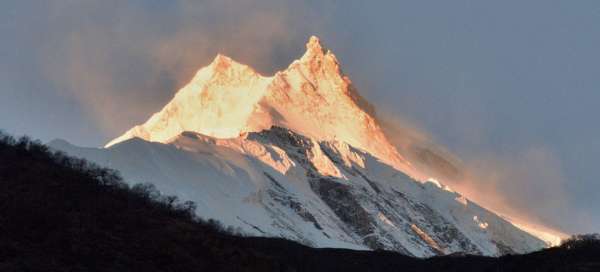
From all the beautiful treks in Nepal, we chose the circuit around Manaslu 8 163m (Ghost Mountains and the eighth highest mountain in the world), which lies in a less visited tourist area, until recently banned border area with Tibet. The road is geographically beautiful and culturally fascinating. The inhabitants of the upper Buri Gandaki are direct descendants of Tibetan immigrants who settled here in the early 17th century. Thanks to that, the language, clothes and customs are exclusively Tibetan. The pearl of the trek is a five-day visit to Tsum Valley – a valley opened since 2010. We went to the trek at the end of October to mid-November and the weather was absolutely luxurious.
1.-2. day
PHA - Belgrade - Abu Dhabi - Kathmandu (approx. 20h)
The flight from Prague to Belgrade will take just over an hour, for which we will change to another, 6-hour flight to Abu Dhabi. In the morning, the 30 ° C desert climate overwhelms us, so we rush to the air-conditioned bus. We have the last flight ahead of us – to Kathmandu (KTM), where we will be greeted by a small but nice airport. Now meet the visa requirement that Czech citizens have towards Nepal and pick up their backpacks. We have already filled out an online application from the Czech Republic, so payment at one counter (USD 40) is a matter of time, as well as receiving a stamp in your passport (at the other counter). We are waiting with great tension for our backpacks and then we go to look for our arranged transfer to the hotel. So far, it's unbelievable, but everything works. Nepalis smile, they are nice, and when I see a sign with my name, they convince me that they have their order in the local chaos. Thanks to the current peak (17:30), we reach the hotel after an hour. At least for now, we soak up the atmosphere of the city and it tastes quite smog. The young people will bring us 20 kg of backpacks up to the 3rd floor, so in a surge of euphoria I spend the first dollar as a tip. The room is priced at $ 4 / person, but we don't need anything more than a bed with a perfectly clean sheet at the moment. Because we live in the very center of KTM – Thamel, we set out on a short exploration of the surroundings, just long enough so that we can't get lost the first night. Tourists, motorbikes, taxi drivers and rickshaws flow through the narrow streets. All in both directions and with the indispensable sound of horns. Smog and dust are ubiquitous and I won't get used to it in a month.
Day 3
Kathmandu
The capital, with a population of over a million, is a bustling and, by Nepalese standard, a modern metropolis. It lies at an altitude of about 1400m above sea level in the green valley of Kathmandu Valley. We start to get to know him at breakfast in a nearby restaurant with the strange name Hello Kitty, where Mim, a guy from the agency, arrives to see us, who remotely provided us with all the necessary permits and arranged a guide (guida) for the trek. The time shift, which is perceived mainly by my stomach, does not allow me to have a rich breakfast (although the offer and prices are very tempting). We will accompany Mima to the Immigration office, where the original of our passports is said to be needed for the last permit. We hope that the bureaucratic buddha will be merciful to us and take only a few hours to process. It really happens too, so we can go back in the afternoon rush hour. We will perform at the Garden of Dreams, which I read about in the guide and for 200 Rs. we enter a medium-sized, well-kept garden. In a quarter of an hour we have nothing to do here, so we leave the place and visit the local ATM, because after paying Mim we calculated that we somehow recalculated at home and need much more money than we have… We go to Durbar square which is on the world UNESCO heritage. After the 2015 earthquake, this place also suffered serious damage, so we are not surprised that the entrance fee has almost tripled (1000 Rs.). Nevertheless, this place is worth a visit. I just don't know why local vendors offer tourists a violin or a flute. In the evening we get to know our guide – which is practically called – Mim.
Day 4
KTM - Arughat Bazar, 9 am
The first bargaining with a taxi driver and immediately unsuccessful. It seems to us to pay 500 rupees for 10 minutes. This tax is said to be common here, but at any distance, even to the airport. In my mind, I'm taking a point from the Nepalis and we'd better look for our bus. We only take an hour's delay, but at KTM we are still being put by the police to check the bus overload (for safety reasons), which of course we cross several times, so the load, heavily pulled to the roof, has to go down again. We take another hour before the bribes and translation of the cargo are resolved, so in the meantime we get to know Mime. The journey continues with two stops for food and the toilet (it vomits when driving into a bag). Although we are sitting, I hit the front seats with my shins and more and more passengers stick to me from the alley. The last section leads through serpentines, a typical, dusty meadow with views of rice fields. When we get out, we have a black T-shirt almost white and a white handkerchief almost black. With effort and relief, we throw our backpacks on our backs and walk to the Manaslu Hotel in exactly 25 minutes. We pay 800 Rs for a room for 3, we order dinner and give the first shower in the mountains. Not what one would enjoy, but pretty cold on the concrete dirty ground with lying (rather) unidentifiable objects and in the twilight, as it's five o'clock and it's getting dark fast. In the evening we even catch the last wifi and say goodbye to the world for another 17 days. After the wifi in KTM haunted us at almost every step, I would lie that I was not pleased with the absence of the Internet and the world around me.
Day 5
Arughat - Lapubesi, 22km
I knew that I had a heavy backpack, but that I would have it the hardest of all upset me. Will I never learn to pack? Since we had not somehow agreed in advance on a carrier that would carry some of our things, we ask Mima if this stupidity of ours could not be solved in any way. He says he will try to ask, but he doesn't promise anything, because a lot of people have left the mountains for the festival and those who stay have a different job. After a few kilometers, we all blow. I have the desire to distribute sweets for the next 17 days to children in the first village. Fortunately, we're building for lunch early. Surprisingly, instead of lunch, the mime starts washing his two white cotton sweatshirts, which he has for the whole time. After eight hours of travel, mostly cut into the rocks above the river, where caravans of mules, porters, tourists and locals pass, we are in Lapubesi. We will spend tonight in a room under the roof, in which the locals have built a chicken coop. Down in the village, day-old chicks (broilers) were sold, which then had to travel in a box on a carrier's back in about 30 ° C heat. At dinner, Mim has a local brandy – raksh, which tastes like diluted self-propelled, but seems to be undiluted, so we listen all evening about the history of Nepal and Buddhism. Because he is a Buddhist and it is basically a very peaceful religion, so is Mim. We will most likely not find the carriers, so he will offer to carry some of our things for us (unlike us, he has a half-empty backpack). Personally, I like the idea, but I'm sorry about his and his not-so-good backpack in advance, which is ready to be thrown away at the end. My conscience calms down a bit that the information that he did not buy a backpack, but received it.
Day 6
Lapubeshi - Tatopani, 15 km
For the first time, I have „Tibetan bread“. I wonder what is hidden under this name and since I have no appetite for pancakes, pancakes or porridge, I try this sweet fried langoustine with jam. We race all day with mules and so unfortunately we have a pretty slow pace, moreover with swirling dust as a bonus. The temperature rises to thirty, so I very much welcome our Guido's decision to declare Tatopani („hot water“) final, where mineral springs with a temperature of 20 and 40 ° C flow out of the rock. They are right on the main road, where crowds of people are constantly walking, but even that does not deter me from going straight away to wash the dust, so we wash and wash our hair in hot water and guess how long it will take someone to build a pool and lure him tourists. Monkeys wave at us from the smoking rock, so we prefer to filter the mineral water.
Day 7
Lapubeshi - Phillim, 12 mi
Along the way, we get rid of candies for children as much as possible, which greet us from a distance with their hands clasped and the call „Namasté“, and the smarter ones add the suffix „give me chocolate“. We soon start not to hear about this theater and we hide candies in more remote villages. The road is full of huge waterfalls, villages are landscaped, a lot of broken slate is used here. At times, the landscape reminds me of our Tatras or the Alps, but on a triple scale. In front of Phillim we will cross one of the longest suspension bridges in the Himalayas. We will spend tonight in the porter's room, we will hardly move here, but for that we will order a bucket of hot water for a „shower“ and again all three will be enough with it. The food is really great (what about the village, other ingredients and tastes), the menu does not lack pizza or macaroni, or even apple pie from fresh apples.
Day 8
Phillim - Chumling, 10 mi
On this day, we will officially say goodbye to the Manaslu circuit for a few days and turn to Tsum valley. This unique valley has been open since 2010 and forms a Nepalese promontory towards Tibet. So mostly Tibetan refugees have lived here for several generations, they farm very modestly, without technical conveniences they find it difficult to cultivate their fields with the help of yaks or buffaloes, but despite the fact that most of them do not even look at Kathmandu for a lifetime, you will not see them cloudy. The whole family is involved in the work. After an eight-hour walk (with a stop for lunch), most of which was a challenging climb, we cross the newest wooden bridge (the only one that connects this valley with the world) to Chumling (2400m). We were afraid of landslides, which Mim had already pointed out to us in KTM, and it was not certain that the valley was passable at all, but in the end it was only a short detour across the river behind the village of Lokpa before the road over the river arrived. Eagles circling over the high mountains, it's an amazing show. We stay in a very nice, wooden house, where locals also live. We try the first „dal bhat“ (a typical Indian and Nepalese dish that consists of rice, bamboo curry, vegetables and lentil (legume) sauce, (sometimes fried with pieces of chopped chicken) and it's really delicious. This dish tastes different everywhere, but they add it everywhere, so it pays off for people who are generally very hungry :) Our guide always gave it, every day. It is cooked in large quantities and eaten mainly by locals (with porters and guides) together in one dining room, with their hands. Apparently it is popular also because the saying goes here: „Dal Bhat power, 24 hour“. On the contrary, Darina and I had half of it, because we wouldn't eat a whole portion, let alone adding it. Garlic soup is also excellent. Here, as in one place, we get fresh vegetables to eat – white radish – which we literally throw ourselves into. The evening sky is incredible, I don't know a better program than the night sky with millions of stars and a beautiful milky way.
Day 9
Chumling - Chhekampar, 11km
We leave the cozy courtyard and climb to another village, which lies already at 3000m above sea level. The only diversification on this day will bring us a meeting with Mime's father, who also makes a living as a guide. Another attraction in this dusty section is wild marijuana, which appears at one stupa. The stupa is a Buddhist structure that is a symbol of peace and tranquility. It is filled with Buddhist relics. They bypass clockwise, which has a positive effect on the mind. Gradually, the beautiful scenery of the holy Ganes Himal, a mountain of seven thousand with several 6,000 brothers, appears to us. In the steep serpentines we pass a waterfall, from which I enthusiastically draw water, even if we are not far to the finish line. We will walk to a completely newly built hotel. Although it still smells of wood and is clean here, all the insulation is formed by one layer of laths, through which you can see outside and which, perhaps, blow pleasantly in the summer. But now the temperature in the room at night does not exceed 8 ° C, so the morning jump out of the sleeping bag is a bit stiff.
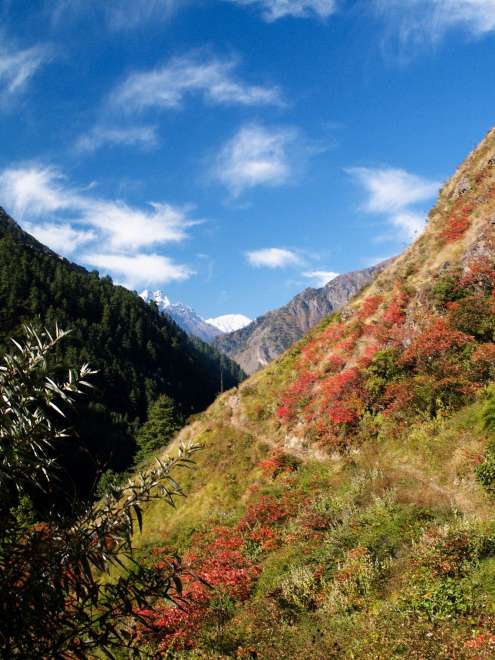
Tsum Valley
on the way to the village of Chekampar
Day 10
Chhekampar - Mu Gompa (3700m), 33 km
We decided for a day trip through the beautiful valley to the monastery of Mu Gompa. It lies at an altitude of 3700m and so the height can be easily felt during the final climb. We leave at half past seven in the morning to get back behind the lights. After all, it is a route that some tourists spread over 3 days. The weather is slightly freezing. We're doing well, we don't have a backpack, just water and clothes, but I'm still short of breath. We pass the first large (women's) monastery – Rachen Gompa, where we will go tomorrow. We will reach the first village at a fast pace an hour earlier. We meet the first yaks and their herders. They are beautiful and very tough animals. They don't mind people, but you need to be careful because they are as upset as they can be and how dangerous they can be. Finally we arrive at the monastery, from the roof of which we have a breathtaking view all the way to the Ganesh Himal. On the other hand, we wave to Tibet, where Mim's white cap almost flies. We go to the monks' kitchen, sit in the dining room, where it blows a lot, so after a while we stand in the kitchen and press ourselves on the bench for monks. We watch a shapely monk chef cook lunch on the stove for the locals and for us at the same time. Black tea and soup with Tibetan noodles seem better to me at that moment than dumpling soup with sirloin :). Before we finally leave this place, we have to enter the prayer room. On the long way back, we walk along with yak caravans around dozens of stupas, through fields and villages of locals. We will still walk in the lights, but I can no longer feel my feet, it was too much for a day trip.
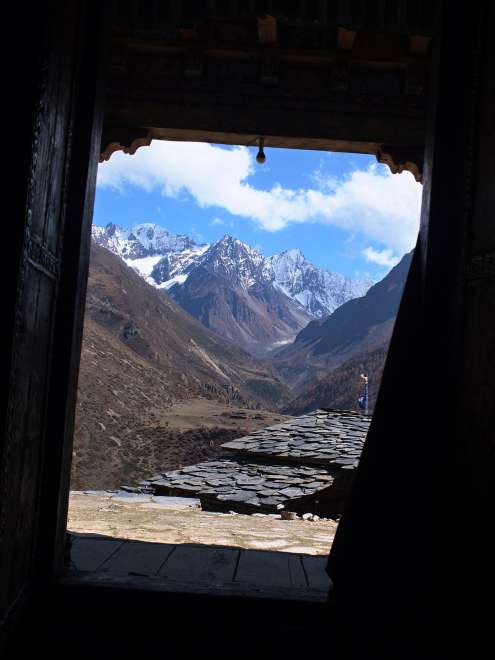
Tsum Valley - Mu Gompa
view from Mu Gompa monastery
Day 11
Chhekampar - Chumling, 16 mi
We will go to the female Buddhist monastery – Rachen Gompa. Without a backpack, it's great again and in an hour and a half we are in the monastery. We address the first nuns, who, however, look like monks thanks to the short 3mm cut. We visit their prayer room, which is much more modern and larger than yesterday's. There is a lot more light and parquet (so our feet don't freeze because we had to leave our shoes in front of the door). English is being taught outside: „Where is the shoe, I brought yesterday?“ We will not visit another monastery opposite in the rocks and we will return, after all we will have a long descent. We also have pumpkin soup (with pieces of pumpkin) and it's a nice change after all those noodle variations. Then we set out on a descent through a dusty but very photogenic valley and look forward to the excellent Dal Bhat again, which we had here 3 days ago. Yeah, and there was a dog running with red eyes, which shone (blue) at night… .that when a person (unintentionally) shone a headlight on him :).
Day 12
Chumling - Deng, 14 mi
We leave Tsum valley and connect to the original circuit, where we have more views and also more tourists. The higher and further away from civilization, the higher the prices of food. The strange thing is that we still pay an average of 100 crowns for a room for three, but the price for a meal doubles. It costs a lot of money or a lot of hard work to bring some food here. The price of tea and water is also rising (a large, about 2.5 liter thermos of water costs CZK 200). In the last village in Tsum, where we stop for lunch, we hear Czech for the first time. The voice is even familiar to me, and I bet I've heard it before. The group of about 10 adults is from CK Namche and their leader is none other than Radka Tkáčiková, who has been an expert on Nepal for several years. They manage to tell us that there are three Czechs in BC at Manásl who are trying to reach the top, so we are curious if we will meet them. All day we walk along the river, a monotonous and endless landscape, here we meet a grandfather leading a cow with a basket full of grass from the pasture. We tread both robots and make ourselves more pleasant, at least in the evening, when we discover rice with vegetables and tuna in the menu. We fall asleep in wooden huts behind the roar of the river and again quite stretched through the walls.
Day 13
Deng - Namrung, 18 km
In the morning we try to repair the microflora and order Masala tea, which is with milk that I normally do not drink at home in the morning. I don't even like butter tea, which is too aromatic for me thanks to the sweet spice, but change is life. In the end, the fears about milk will not be confirmed, but I will not experiment any more in the morning. We leave the hotel with the nice name Shangri La and after a while we cross the rope bridge to the other side of the river. The road is quite steep, in some places we climb wooden ladders and after a while we are high above the river. In the first village, we decide to take a moment of rest and sunshine and wash our hair in the morning to dry it during the day. During the final two-hour climb to Namrung, we meet a group of carriers, each of which carries perhaps 40 kg (they have two backpacks connected into one and tied with a rope, supported on their foreheads). One oncoming will greet us „greet“, which is a Russian greeting that will surprise us like an Eskimo in the desert. He probably carried luggage to Russian tourists, who were said to be here, but we never met them. Mim said he had learned from their porters that the Russians did not eat breakfast in the morning, then stepped all day and walked vast distances. Namrung is a larger village. Mime promises us wi-fi, but it doesn't work, even though her logo is on the sign of every guesthouse. We get a small wooden hut, where we can fit with our backpacks. We quickly order a bucket of water to wash and then move to the dining room, where I will be pleased with the same water filter as I have – Sawyer. It also works on the principle of gravity, so the water poured from the top flows through it and we can drink it already filtered. We have a large thermos of ginger tea for 240 CZK and a mix of chowmain (Chinese noodles), which will not surpass anything later, because they are incredibly good, even with yak cheese.
Rope bridge from Deng
one of the worst bridges along the way
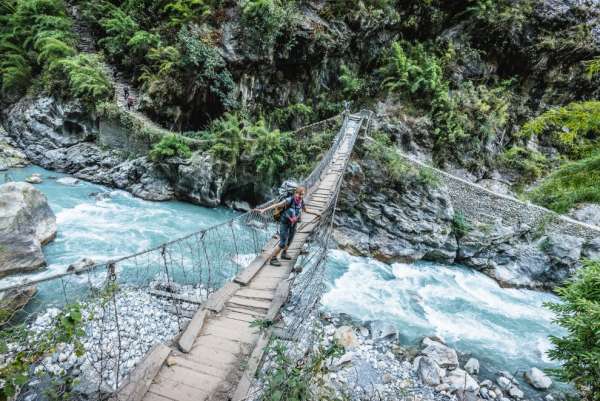
Day 14
Namrung - Lho (3181 m), 13 km
The higher we are, the shorter the sections. But every day looks similar. Breakfast at 7.00, then 3–4 hours walk, an hour's lunch and another about 3 hours walk. Today, however, we end our lunch, we have a half-day lead and we like this place so much that we will stay here. For the first time, the queen of the local mountains, eight thousand Manaslu, appears. It's a beauty to move in the foothills with golden larch trees, where this majestic mountain rises five kilometers in height. The harvest season is just coming and the people in the field are doing it at the same time as the children, but they are trying to run to the fence to stretch their hands for some sweetness. The local potatoes are renowned and really delicious. We will go to a nearby monastery designed to raise boys. It lies on a gentle hill, from which there are great views of the whole village. At the other end of the monastery we discover a baseball field with running monks in long robes and also a solar shower system. We envy a little (or rather a lot) just coming out boys with a towel on their heads, because we will see a hot shower first in KTM. We meet Mime's father Basanta, whom we have finally arrived, and his clients from the USA, and we enjoy the view like a Matterhorn over coffee. For the first time, he starts drowning in the dining room in the evening. However, the heat is only around the stove, so we are still sitting 2m from them in a down jacket. But there are also those who can sit in a down jacket right next to the stove. They are Indian students who are doing a survey or a census here, and according to their expression, I think that cold evenings are a real suffering for them. In the meantime, we are talking with the locals about People in Need, who is very active here (People in need), and about Pavel Bém, who comes here regularly (he was here 14 days ago) and financially supports the local village. In one hotel (which was one of the „more luxurious“ ones), we discover his calendar, which he issued in support of this area after the earthquake. When we go to sleep, we hear a constant pounding in a regular rhythm, as if the thresher is stuck… On the way to the toilet, I notice that in the backyard behind the cottages, thistles are threshing. Through the eyes of tourists experience and return to the last century, through the eyes of locals quite a common thing.
View of Manaslu
the view of Manaslu we had from the village of Lho was absolutely famous

Day 15
Sama Gaun, 11 km
Today we only have 4 hours of walking, so we are not in a hurry. The first half we go partly through the forest in the shade (it's not for several days on a T-shirt and shorts), we talk to Mim about local customs and, among other things. we learn that if there are more children in the family, they marry gradually from the oldest. We cross another of the rope bridges into the village and the last section is already a large and wide valley with lying yaks. From Sam Gaun, climbers usually go on expeditions attacking the top of Manaslu, so there are shops and also more hotels and accommodation options. Cabbage, cauliflower, lettuce and carrots still grew in the modest gardens at 3000 m. We are already at 3500 m and we don't see any gardens. Nevertheless, the menu of some vegetables is always on the menu. We go to a nearby monastery, where the ceremony is taking place, the monks are sitting outside and spinning their drums (which symbolizes the circumference of the stupa), burning twigs of yew, so we just sit here, watch what is happening, try to transfer the atmosphere and meditate with them. After the third hour, the sun sets behind the highest hills and suddenly we find ourselves in the shade and also immediately pull out our jackets, hats and gloves. Since it's far from dinner and I don't want to be in a cold room, Mim and I go to the police station to check our permits. In the evening we drink tea and prepare mentally for tomorrow's rest day, when we have planned a trip to the Manásl base camp as part of acclimatization, which lies at an altitude of 4400 m according to our map. However, we will find out that it is 4850 meters above sea level the next day.
Day 16
Sama Gaun - Manaslu BC (4850 m asl), 18km
At 6.30 we set off on a long acclimatization trip to the Manaslu base camp. The road leads for about half an hour along the river and then rises. First through a slightly grove, and when the trees disappear, it begins to zigzag upwards to the views. We try to drink a lot, fortunately we cross the water from the glacier several times. The higher we are, the more the huge moraine opens up, which creates the impression of a massive rock, but the cracking and massive cracking and landslides of the glacier are living proof that it is not a rock. When we see the first flags, we begin to look forward to the end of the endless ascent. But it is only a harbinger of old BC, it is another hour's walk to the new one. We can't wait to be such a pearl of our trek. In BC, however, no expedition, even if the conditions are so excellent, does not attempt to reach the top. We will enjoy the snack and after half an hour we will go down. Darina suddenly faints halfway, so Tom supports her and leads her down. We will almost run the road. We all have glasses full of it, we have garlic soup, even though the garlic is probably not in it. In addition to the soup, we also treat ourselves to a shower, which, however, does not fit Darina, who totally confused her exhausted organism (first with height and then with temperature), and he reacted with a huge chill. So we have fun for the next hours, we get various advice, we warm up Darča, we ask about the possibility to call a helicopter, but most of all we hope that it will pass. The helicopter is quite a complicated and especially expensive affair. Only locals have a signal here and we don't have a satellite phone. I can't wait to go to bed, it was difficult today, my head hurts and we have to decide in the morning how to proceed.
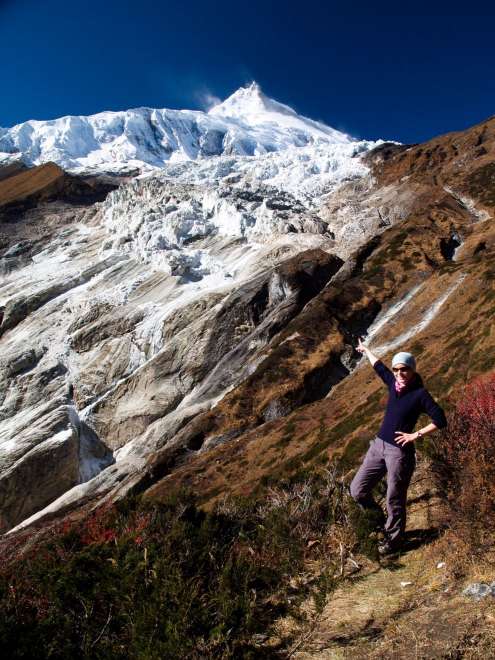
On the way to BC
Climbing to BC through a scenic landscape under the supervision of Manasla herself
Day 17
Sama Gaun - Samdo, 10 km
The night goes well beyond my expectations and we all sleep. But my head still hurts. After breakfast, we find out how the local telephone with the helicopter call is doing. Darina still wants to leave the mountains at all costs, so we go to the biggest hotel, where we feel like in another world. Large and clean dining room, reception, Pavel Bém's calendar on the wall. Behind us will say: Hello Č. Hi, hello Slovaks! Before we realize that the address in the empty dining room belongs to us, it takes us a while :) Our Tom is Slovak, so we create an interesting, Czech-Slovak party. We will talk to our new acquaintance, who is none other than one member of the Czech expedition, which we heard about on the way from Radka Tkáčiková. So the Czechs had already come down, so we didn't see any tent upstairs. She has a nice bruise under her eye and looks like they definitely enjoyed it upstairs. He offers to Darina that he can join them, because they are still descending today (the same way we went up). However, they have much longer sections ahead of them than we went up, and they have to manage our entire route of about 8 days in 4 days due to the return flight. They have ordered mules for backpacks and materials. We are only two days from the saddle and we have very short sections. Darina decides to descend. We therefore have to complete the formalities and communicate this decision to the agency in KTM, so that our guide is no longer responsible for it. We say goodbye around ten and our paths will be divided. We continue up, complete the circuit, Darča out of fear for her health down. We should arrive at KTM at about the same time, perhaps with a one-day difference. We arrive in the village of Samdo after three hours. The path leads pleasantly along the contour line, only to the end it rises a bit. We find ourselves closer to the Tibetan border, which are already visible over the hill. We will spend dinner with a group of Dutch people who have a chef. It works by borrowing a kitchen and cooking its own three-course meal. Today they have tomato soup, but it stinks completely artificially, so we don't envy them. The second course looks better, they even get fries (we envy a little bit) and they stuff themselves until they have bumps behind their ears. I'm overeaten from my own food, so luckily I don't look too sweet. We just wonder how around them the porters, cooks and the whole companion bounce like trained monkeys. Apparently he knows that this is where the dagger comes from. Their leader even went to another village for 4 hours to book accommodation for another night, which is usually limited in capacity.
YAK
guardian of the mountains

Day 18
Samdo - Dharmasaala (4400m), 10km
Once again, we stare at what the Dutch are able to eat. It starts with oatmeal, continues with pancakes and ends with an omelette and they add it to everyone. So we pour a piece of jam for our „poor“ Tibetan bread. We go to the next village for 3.5 hours. The sections have been short for the last few days, so we are already looking forward to climbing the saddle and going all day again. Because Dharmasaala is not actually a village, but rather a camp from which to go to the saddle, it is sometimes a problem to find accommodation, so some guides come here the day before and make reservations for their customers for the next day. When we arrive, Mim's father holds a place in our tent (where he shields the mattress for the first time). So we don't stay here much and we go out in the sun, because even though we are very high (4400m), it is beautifully warm. We sit on the stones and lean against the wall of the local dining room, finish our overpriced soup, drink 3in1 coffee and be a little loud with a dream of strudel with whipped cream. It says, „You'd really like that, miss.“ We turn our heads and see a nice guy sitting next to us, about 70 years old. Another funny story comes from the Dutch, who boast that they plan to climb Larkya Peak (approx. 6000m) and do not know that their guide asked ours during the day with a map in his hand if he knows which mountain is Larkya Peak. We have dinner in the common dining room, which is for everyone and therefore is very crowded (in other words, crowded) with all nationalities. A nightmare is mainly a visit to the toilet, which is also only one for the whole camp, the door cannot be closed and so most still go sideways. So we don't sit here unnecessarily, we go to sleep and prepare for the morning panic, because everyone is going to get up before 4 o'clock to get to the saddle in time. We have a different opinion, but we do not want to refute it.
Dharmasaala
„tent camp“ in front of Larkya's saddle
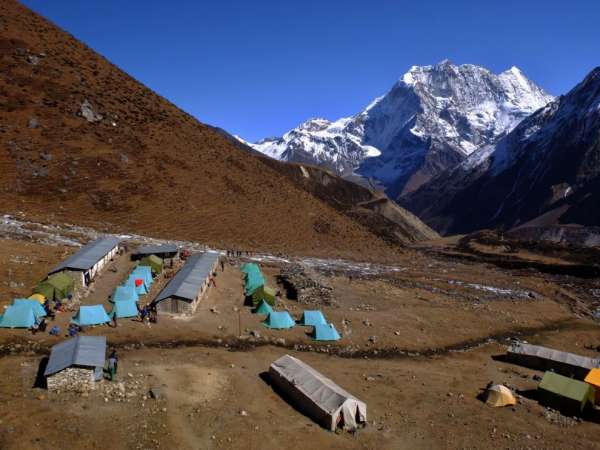
Day 19
Dharmasaala - Bimtang (4400m - 5100m - 3700m), 19 km
Eventually, at 3:15, Mime's father wakes us up. Even though we still don't understand it (it's a 5-hour slow walk to the saddle), we get up and go for a pancake to avoid the crowds of other tourists, who are gradually starting to appear. We will have chapati with omelette on the way. Rows of lights begin to form above the camp, which slowly leaves this place and we all climb to the finals of the whole trek – the saddle Larkya pass (5100m). There is ideal weather outside, it is windless, it seems to me that it does not even freeze and it is beautiful. Finally, after 14 days, the Big Wagon is visible. At times we turn off the headlights and watch the theater in the form of shooting stars. We are slightly climbing in the saddle in 4.5 hours at 9:00. We swear a little on getting up in the morning, but it is said that around 10 he starts to blow a lot in the saddle. Whether this is the case or not, we will not find out anymore, because as soon as we take a picture, we will fall in love and have a snack, we will start to decline. It's not a horror movie, as many have described, but a pretty cool descent. Even so, we give our knees and shoes a hard time and I'm very happy when we arrive around one of Bimtang, where Mim's father is waiting for us again with the booked accommodation (this time 100% better) in new wooden cottages with a clean bed. At dinner, I get a message from the movie Pelíšky if „shit is burning“. Well, maybe yeah yes :) and it's quite warm. We are in a good position and we are sitting right next to them, so we can enjoy dinner and apple pie. Unfortunately, our neighbors are again Koreans, who also have down pants and face Everest. They order expensive alcohol and we are sorry for their guide, who is constantly bouncing around them. Mim's father comes to us and explains to us in about half an hour in broken English that the next time we go to Nepal, we should contact him or Mima straight away. In short, we save and they earn more. However, when I return, I recommend Mima, known as Guida + carriers in one to Annapurna, he unexpectedly pays twice as much as the carrier would cost through the agency. So that's the Nepalese mentality.
Larke pass, 5106m
the highest point of the trek reached
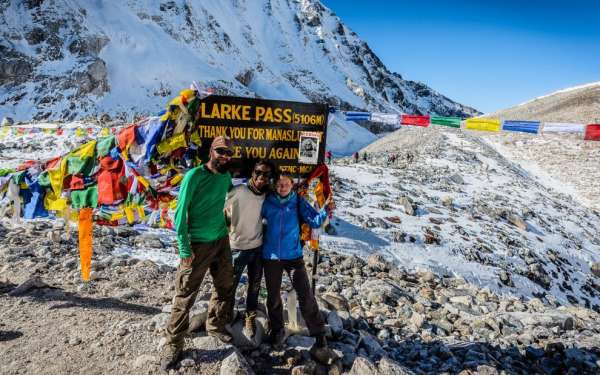
Day 20
Bimtang - Dharapani, 17 mi
We are looking forward to breakfast in the frozen dining room. We enjoy the last view of Manaslu north and enjoy another landscape – wild sea buckthorns appear along the river, we walk through beautiful forests. After a long time, we see the first signs of civilization, the effort to build roads almost without heavy equipment is very sporadic and thanks to the hard work of the locals. Because we want to walk to the village, where Jeeps drive, we stay almost at dusk. The hotels here have a funny to kitschy impression of the Ukrainian style (the more colors, the better). Finally, there is a „normal“ shower, from which we manage to get 25 ° C hot water and finally wash with more than two liters of water.
Day 21
Dharapani - Jagat - Besisahar - KTM
In the morning we are pleased to know that the jeep to Besisahar leaves at 8.00 from the police checkpoint (next to the hotel). Less price (3200 Rs. / Pers., For non-bats 1000 Rs. – but it stands on the body all the time and it's not much to envy). We have a break after 2 hours. The mime looks like he was pulled out after 10 days in solitary confinement and that he will either vomit or pass out at any moment, but when he takes off all the scarves he has around his face, he even laughs for a while. All Nepalis are here in feathers, and we are again convinced that the password is valid: +30, minus 30 = Nepalis still wear the same clothes. The road is really steep, there are two Germans sitting behind us, 1 Swiss and 1 Nepalese. At times I wonder what „stairs“ a car (Indian TATA) is able to drive. I sit next to the driver (who is on the right) and we bump into each other all the time. The next day, my right hand hurts, which I refused to keep from jumping on his lap. After 5 hours we will arrive in Besisahar. I'm really glad that we don't have to spend another night in this dusty town, and we immediately take a minibus to KTM. The price is 800 / person. Unfortunately, we sit on the four-seater at five, so we squeeze with the Nepalis all the time. The mime, on the grounds that he has to sit in the front because he is sick, is sitting next to the Swiss and the driver. Fortunately, he is merciful and stops about 3 times along the way. We eat local fast-food dishes (eg pakodu – fried onions and cabbage in some majda or peas with chili) for a few crowns and we are curious how our stomachs fit in after so many days. He did it perfectly, as he did basically. The road ends somewhat unexpectedly, when suddenly a car on the edge of KTM skips and we have to do something to avoid getting off the road. Our front wheel has flown away (literally with everything), so we are already ascending in the dark on the street and looking at the hole that remains instead of the wheel, it is clear that this car has already arrived (today). Like a few other cars we met along the way in a scarp. The Swiss woman, who got out of that place next to the driver a few minutes ago, was really lucky. Nothing happened to anyone, so we take a taxi and drive to the hotel on our own. We fall on the bed and suddenly everything is different. Now the ubiquitous wi-fi is sticking to us again, which can hardly be resisted, so we find out nice and unpleasant news, which left us completely calm for 17 days. For example, the results of the US presidential election. With the effort of the last forces, we wash the dust from each other after 12 hours of driving and fall asleep.
Day 22
Back in Kathmandu
Unfortunately we have to move from our favorite guest house Annapurna to another (Red Stone). Although it is across the street and for the same price (15 USD / room), the quality is significantly worse. The sheets seem to have had enough hard nights with previous guests. We have three nights waiting for us and not a single day of hot water flows. But even this belongs to Nepal, if we don't take the bedbugs, there's nothing to complain about :). After a good and cheap breakfast, we head to Boudhanath Stupa, which is one of the largest Buddhist stupas in the world. Last year it was very damaged by the earthquake, but now it is literally getting a new coat of paint. Admission is still very low, 250 Rs. Thanks to a large community of Tibetan refugees, a center with Buddhist monasteries has grown around it. Bodhnath was built in the fifth century and now serves as an important place of pilgrimage for both Tibetan and Nepalese Buddhists. We will have great coffee in a Korean restaurant and even more interesting brownies, which will bring us completely hot until the chocolate melts inside. Then we move to Swayambhunath – Monkey Temple. Due to today's strike by the Maoists, there are no buses, from which the local taxi drivers profit happily and prices double. So it takes us longer than usual to come across a taxi driver who can negotiate a normal price (600Rs). We climb rapidly up 365 steep steps, resisting dozens of running monkeys just to catch a sunset overlooking the Himalayas. We can really do it at the last minute, but we still have an impressive view. Due to the strike, there is little smog and the Himalayas around KTM are literally glowing. Swayambhunath is one of the oldest monuments in Nepal, the original foundations date from the fifth century. In 2010, the stupa was restored and 20 kg of gold was used for repairs. But the ubiquitous and smelly monkeys sometimes terrify me with their fights as they run through the crowds among tourists. In the evening, after five days, we will meet Darina, who will finally arrive.

Boudhanath rises
we absorbed the atmosphere around the stupa with all our senses
Day 23
Kathmandu
The last few days we spend so much shopping that I have about $ 10 left for two days. In the evening we settle with Mime, we give him money for bringing us some things for part of the trek and also a tip (100 €), for which he then invites us to various goodies in the restaurant at Kitty's. Unfortunately, he also orders beer, Danish Tuborgy, which is sweet and sour and fast-climbing. I think if Tom was willing to drink with him all night, he'd blow up all the money he got. But we have an appointment for tomorrow that we will meet at 7 in the morning and after breakfast we will take a bus to Mim's town Dhulikhel, 30 km east of KTM.
Swayambhunath - Monkey Temple
monkey king

Day 24
KTM - Dhulikhel - KTM
Every day in the mountains, with one exception, we had breakfast at 7.00. Apparently it's a Nepali stereotype, because 7 in the morning will be suggested by Mim for today's cruise day. I feel like he regrets a lot in the morning, because the beer obviously didn't do him much good, and when I knock on his door at 7, he just wakes up. I get up at 7 the only one and probably the only one I have a terrible desire to get away from that smog for the whole day. Finally we leave at 9.00 from the bus station near Thamel. Price 50Rs / person. it lifts our spirits a lot. However, I want to go to the toilet, so I jump at the first stop and Mim helps me find him. I hope we have at least a 20-minute break as always, so I decide to buy another tempting-looking cake for the trip when our bus starts. The mime manages to jump up to tell me that the bus has just left (I noticed that) and that it will definitely stop (but not stop) in a few meters. The bus goes on happily, with Tom and Mime's backpack. We catch another bus in our direction and we believe that we will catch up with ours. Fortunately, the mime is completely fine and he doesn't seem to mind this adventure I have caused. The problem is that neither he nor I can remember exactly what our bus looked like. After about half an hour we have a shorter stop in a bigger city, where we fly out and fortunately we find everything, including laughing Tom :) In Dhulikhel we get out on the square about 100 times quieter town than KTM. There is no smog, so we have beautiful views of the White Mountains. Mime lives with his (apparently) cousin in an apartment building. In a small room, they put us on the bed, because there is nothing but a cabinet and a shelf for a double cooker. The homemade dal bhát was absolutely luxurious, again I violate my Asian rule and I will taste the chicken pieces. It tastes great. It is said that a thousand steps lead to the local lookout tower. It is a wooded hill behind the city, in the middle of which stands a huge golden Buddha. The lookout tower, which looked like a lookout tower from below, is a dilapidated (or unfinished) torso of a smaller tower up close. It is forbidden to enter it and I am not even surprised. If there ever was a lookout tower, its structure suffered a lot during the earthquake. However, we still have prospects, and the local army is still working on them by cutting down trees. It is even possible to see Manasla from that distance. Surprisingly, a much better view is under the „lookout tower“. Stones about a meter high protrude from the ground, so we get pretty good at taking photos here. Then we head back to the city, where we walk through the Nawar district, which is significant for its different architecture. It reminds me of the Victorian style, although it's a bit of a mystery to me where the influence would come from. Returning to KTM is literally smog suffering. We are surprised by Darina, who does not look good at all and is afraid that she will not even manage to leave. Still, we take her out to dinner, and even though we wanted to go somewhere else, we end up in Hello Kitty again. Unfortunately, it will be fatal for us. The donors bring 4× bad tea, so it doesn't last mentally and leaves. My rice noodles with tofu and vegetables are brought to me without tofu and without vegetables, and when they fix it, they smell strange. Tom's food is also disappointing. We don't stretch it and we leave annoyed that the last visit didn't work out that way. Darina looks worse and worse, she vomits when we finally take her by taxi to the private British clinic CIWIC, which is about 10 minutes from the hotel. There they give her a dropper, take blood, do some tests and most importantly she will be under surveillance. We leave the hospital after 11 o'clock at night, so the idea of getting a good night's sleep is beginning to crumble. At two in the morning, my abdominal pain wakes me up and I go to the toilet for the first time. Well, so the feeling that the noodles weren't quite right is coming true. Tom wakes up and we take turns on the toilet just like that. Unfortunately, neither of us will fall asleep anymore, because our visits to the toilet are so frequent in the end that we don't even have to take turns in the morning, so we also use the toilet in the hallway. So we run until morning, one vomits, the other with diarrhea and there can be no talk of sleep. It is said that Pharaoh's revenge will overtake everyone, but I have never heard of Nepal. Tom finds out the cause of his nausea, apparently bought spoiled water in Dhulikhel and has problems with that.
Day 25
KTM - Abu Dhabi
Last night in Nepal was really worth it. Tom is considering moving the tickets, but I immediately reject this in my mind. We have a taxi arranged at 14.00. I pick up the leftovers and go buy bananas, biscuits and coca cola. We won't need anything else for the trip. Maybe toilet paper. A small Suzuki with a non-English speaking Nepali will arrive as a taxi. We have to put our backpacks on the roof ourselves and it's still annoying. If we want him to drive 100m to the hospital, he wants more money. At the hospital, we finally pick up the happier Darina and say goodbye to the increasingly sad Mime. He gives us scarves for good luck. We are finally on a plane and I am lucky to have a cheerful companion from Strakonice. I immediately promise him a double portion of food, because my stomach is still protesting and I'm not even hungry. I will exchange my portion for a dry baguette and hand over the whole portion, including the mango cake, to him a little regretfully. In Abu Dhabi, we find a carpet sleeping corner, which is located next to the sleeping cells ($ 100 for 12 hours) – thank you very much. So we pull out the mats and store ourselves in a pleasant horizontal position for a beautiful 8 hours of sleep. At night I have to go to the toilet about 2 times and I always get lost. It will take me at least 15 minutes to walk around the adjacent corridors and find my way back… My sense of direction gets busy.
Day 26
Abu Dhabi - Berlin - Prague
In the morning we have the rest of small, sweet bananas for breakfast and go for tea. I'll get lost again, because the circular hall with side aisles looks like a labyrinth to me. We're on a 7-hour flight to Berlin, and since we're asleep, I use recorded cinema for 7 hours. When else will I succeed again. We will even have food with gusto. Barack Obama is on his last visit to Europe in the presidency in Berlin. We see his US Air Force one parked. One of the strictest inspections takes place here, when they will x-ray us to the bone. We look forward to finishing the event with cappuccino and a great German cheesecake, but they only have Bavarian meatloaf, pretzels and muffins. There is a slight disappointment, not only from the offer, but also from European prices. Three hours over one cappuccino will finally run away and we can finally go to Prague. The mini-aircraft will land happily with us, so all we have to do is wait for the arrived backpacks and say goodbye. I have the furthest to go to Brno, so it is not until midnight that I am thrown away by a yellow torpedo near the Grand. Compared to Nepal, there is 20 ° C less in Brno, so I'm really looking forward to a really hot shower. I get up for work in the morning after November 17, because my vacation is completely exhausted this year.
Kathmandu
view from Immigration office
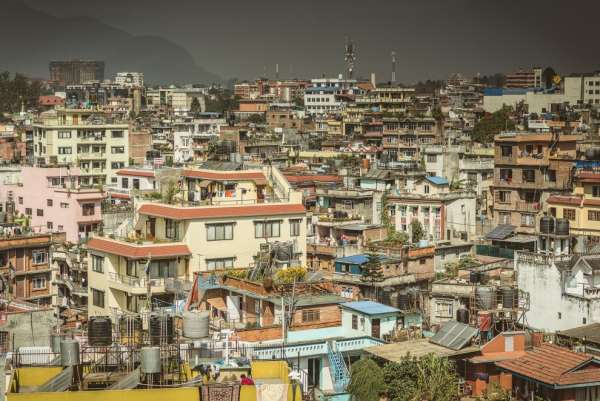
Durbar square
legendary, unfortunately very earthquake-damaged, square
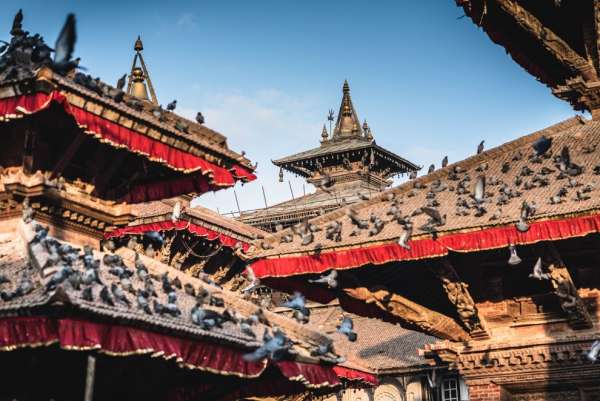
Arughat Bazar
just after Arughat, the first views begin


Little model
beautiful little girl
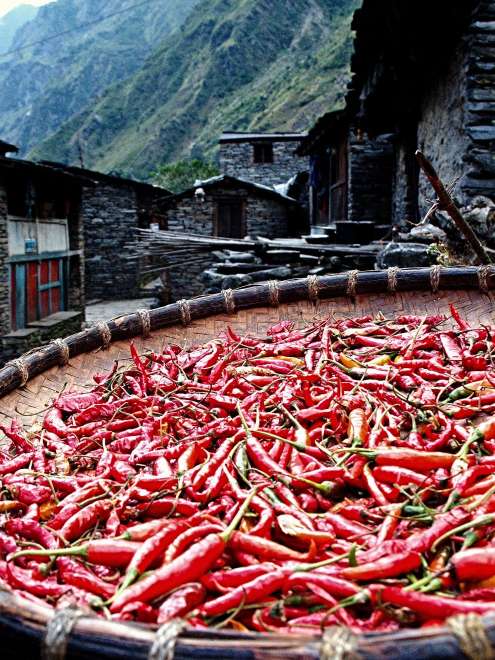
Chilli
typical drying of peppers
Local residents
The Tsum Valley has a very well-preserved Tibetan culture


It's rising
ubiquitous stupas
Mu Gompa Monastery
beautiful view over the roof of the monastery to the roof of the world
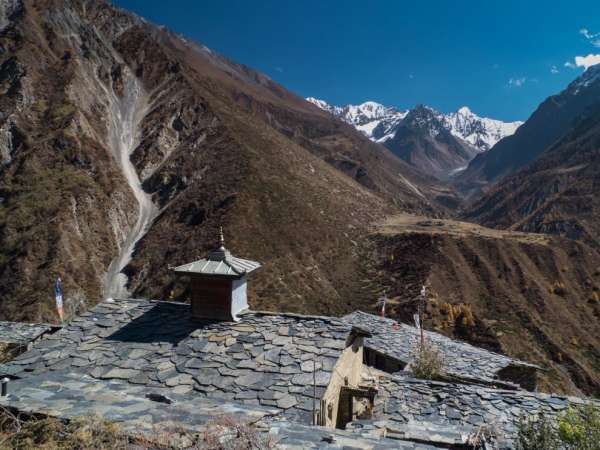
Namasté
…
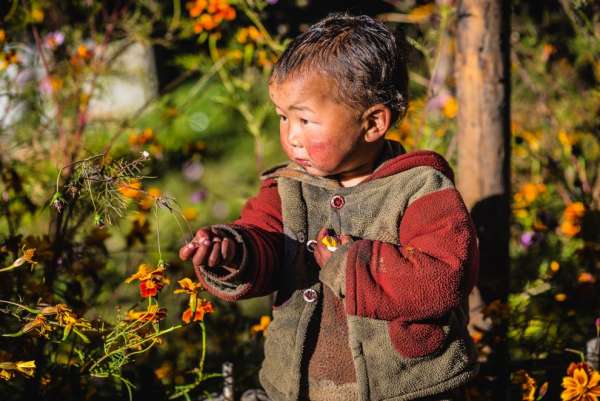
Namasté
…

Colors of Himalaya
…
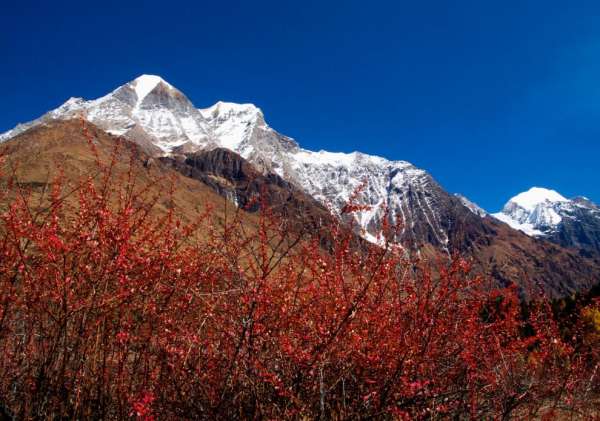
Manaslu sunrice
…
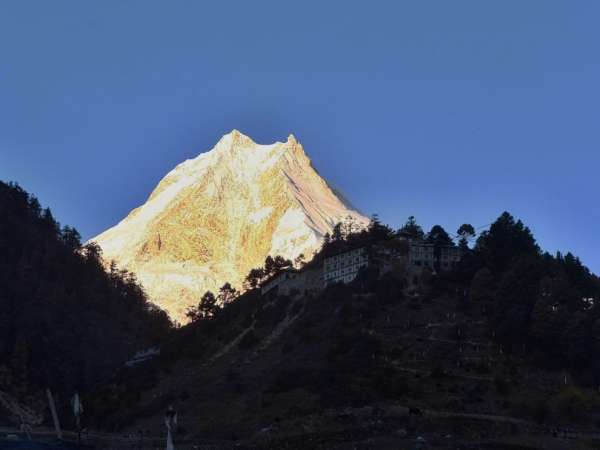
On the way to BC
and yet colorful
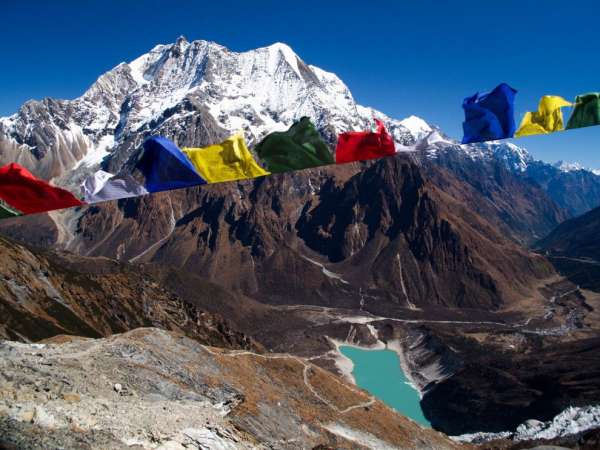
Happy piggy bank in the saddle
…
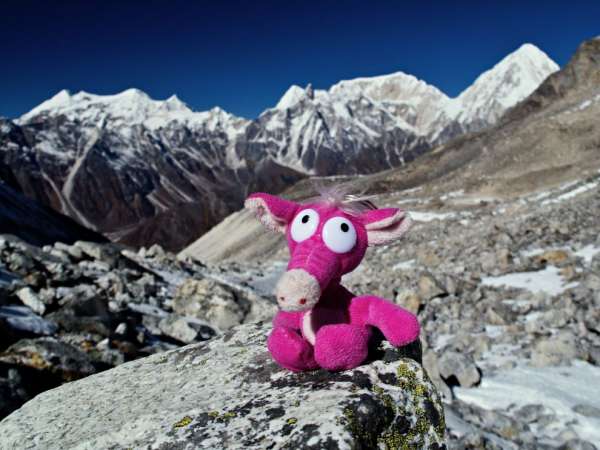
Sea buckthorn
a good dose of vitamins
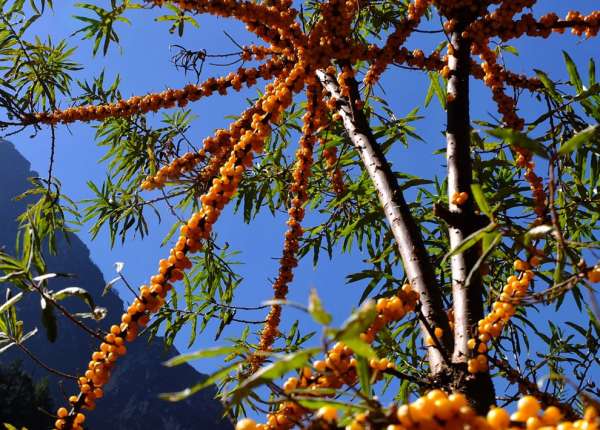
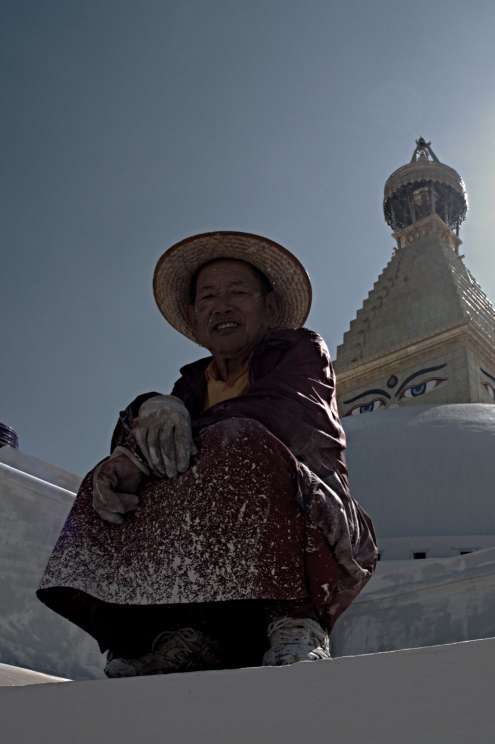
Boudhanath
working monk
Rice field in Dhulikhel
after harvest
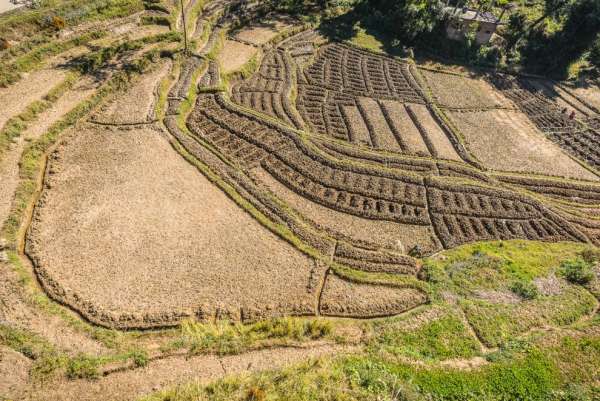
Dhulikhel
sometimes the lookout tower can disappoint and the straight line can surprise

Children
Hello, how are you? Whats your name?
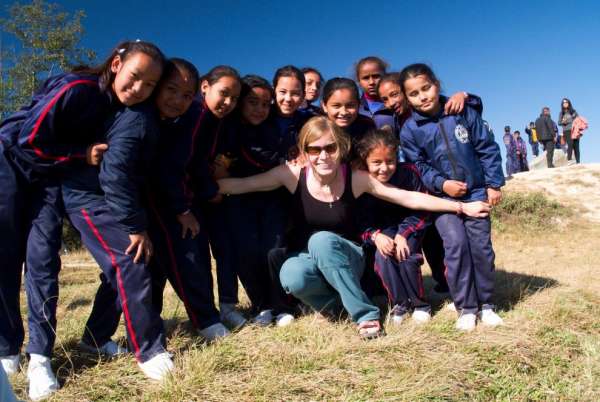
Namasté
give me chocolate
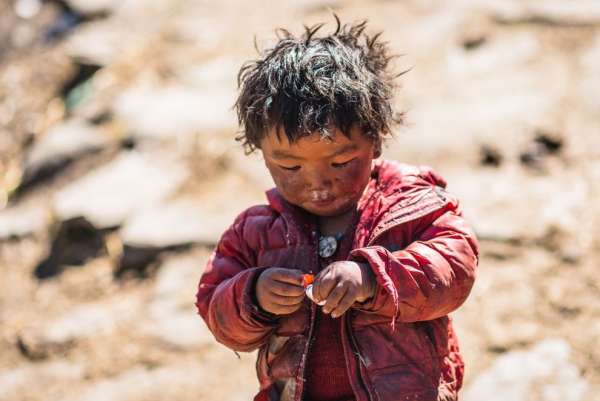
Public baths
a little water won't hurt :)
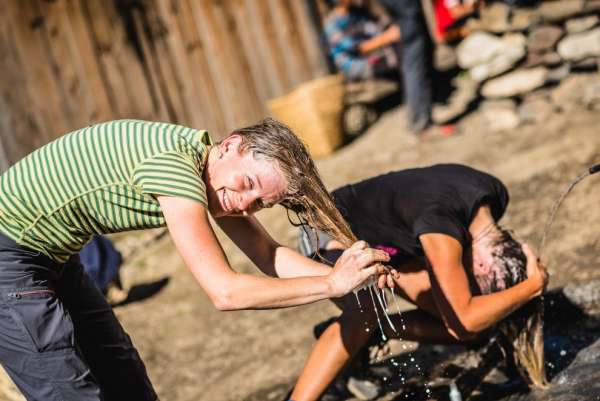
Articles nearby
Practical information
Giga List: The most beautiful treks in the world
In this overview, selected treks that have a duration of at least a week are selected. All of them have breathtaking views,… continue reading
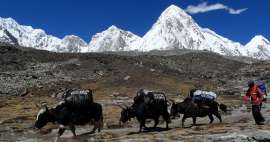
Giga List: The most beautiful Nepalese treks
Thanks to the highest mountains in the world – the Himalayas – Nepal offers some of the best trekking opportunities in the world.… continue reading
